The document discusses a panel symposium on neuroentrepreneurship held in 2015, highlighting the significant interest and attendance it garnered despite limited practical application in the field. It explores the cognitive microfoundations of the entrepreneurial mindset, emphasizing the need for better definitions and rigorous measurement methods, while addressing hindrances in the theoretical framework of entrepreneurship. The symposium aims to bring together diverse scholars to analyze current research, challenges, and advance understanding in neuroentrepreneurship.
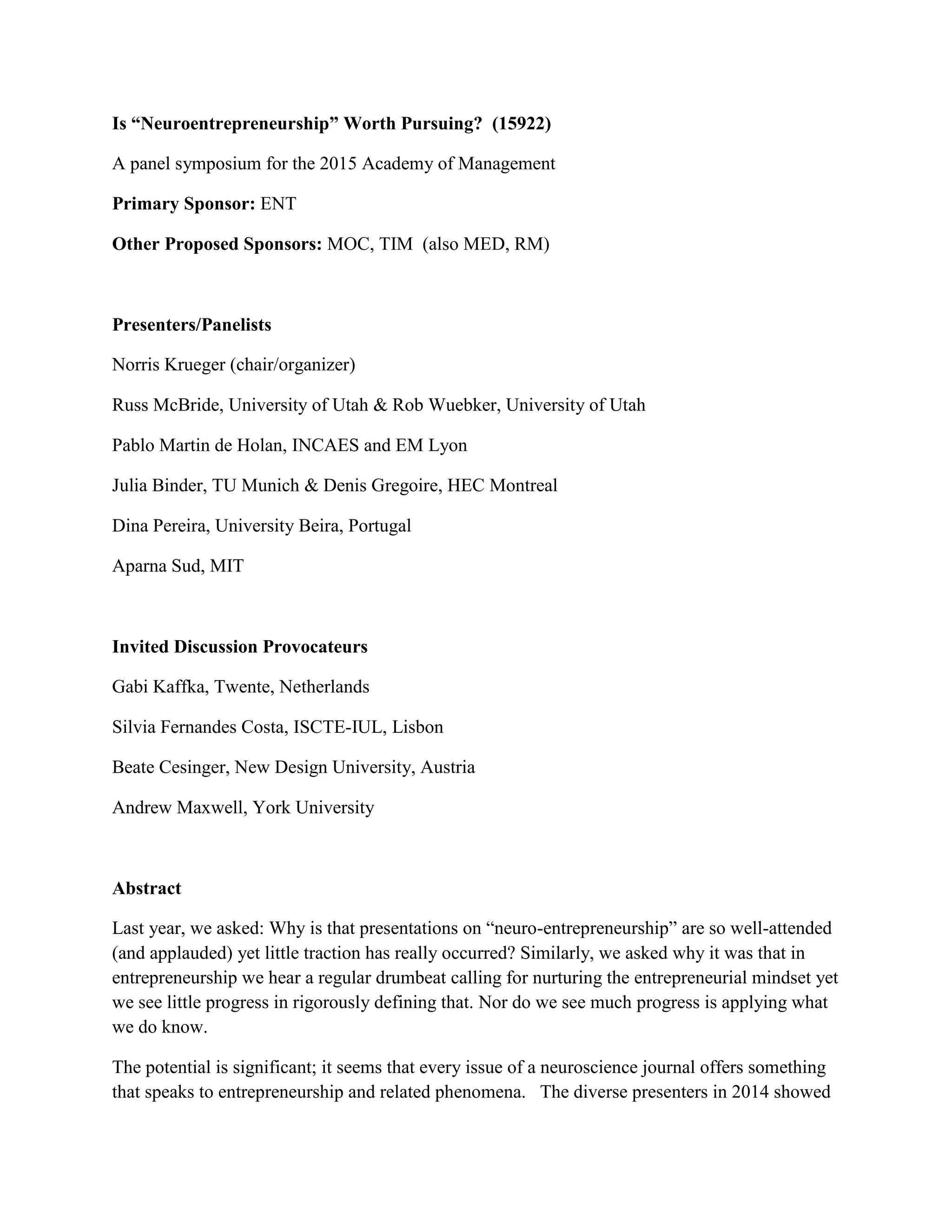

![Entrepreneurship scholars have long nibbled around the edges of cognitive science, in large part
because to skillfully use its theoretical concepts and empirical tools is challenging. However, we
will argue here that the investment will yield exceptional returns [Krueger 2004; Krueger & Day
2010]. Consider these opportunities:
We can ask questions that we could not ask before.
We can ask questions in better ways than before.
We can ask questions that we could not even think to ask before.
In short, looking at the microfoundations of entrepreneurial cognition (and action) through the
lenses offered by neuroscience is a) already giving us new insights to what exactly the murkily
defined “entrepreneurial mindset” actually comprises, b) helping understand how it changes and
c) how we might rigorously measure it.
Value Proposition for Sponsors:
As the overview delineates, neuro-entrepreneurship has immense potential to bring powerful new
theories and powerful new methods to the study of entrepreneurial individuals and
entrepreneurial organizations. It is also clearly speaks to important new insights into
entrepreneurial learning. (If we are to truly understand the “entrepreneurial mindset” we need
these tools.) However, that promise remains unfulfilled despite its apparent sexiness atop its
research potential.
The time has more than come to turn a critical eye on neuroentrepreneurship and its potential,
ask some hard questions and bring together a diverse group of senior and junior scholars to share
their insights and their current work. Doing this in a symposium permits us to also engage the
expertise that might be found in other Divisions and Interest Groups. I hope you can join us –
there will be fireworks.
FORMAT
Dr. Krueger will provide a brief overview of the state of the art in neuroentrepreneurship and
introduce the panelists.
Each panelist will provide an overview of their specific research areas, focusing on what we have
and, more important, what we have not learned to date. Each will emphasize the critical
implications, whether for research, teaching, practice or theory.
We will have expert discussion facilitators on call to further expand on the implications.
Also, past experience with this topic suggests providing time for audience members to contribute
beyond the usual (and all-too-brief) Q&A period.](https://image.slidesharecdn.com/aom2015neurors15922-150507041018-lva1-app6891/75/Neuroentrepreneurship-symposium-2015-Academy-of-Management-3-2048.jpg)
![PANELISTS and PROVOCATIVES
Norris Krueger, Entrepreneurship Northwest [chair]
Overview of current progress, both potential and pitfalls.
The first signs of genuine potential?
Herbert Simon was one of many who long ago noted that what we say and think (and do) is a
deeper ‘symbolic’ level where attitudes and deep beliefs may drive our behavior in ways of
which we are not terribly mindful. Deeper still are neurological and endocrinological influences
that are well below our cognizance but are nonetheless malleable. The hormone oxytocin has
itself become a cottage industry for decision making research. For example, levels of oxytocin
affect levels of trust in us. However, increasing trust will increase oxytocin production.
Note that neuroscience itself is fraught with methodological peril, often producing (and
publishing) exciting results that sadly lack statistical power to support their claims. Moreover, it
is a misconception to equate “neuroscience” with neuroimaging. Much of the very best work is
done via experimentation.
Consider the first entrepreneurship research article ever published in Nature was out of the
neuroscience labs at Cambridge. Barbara Sahakian’s team partnered with the Judge Institute to
compare top managers with serial entrepreneurs on emotion-independent (“cold”) cognition and
emotion-dependent (“hot”) cognition, finding that the entrepreneurs preferred and were better at
hot cognition. It is easy to see the possibilities for extending this model.
Welpe and associates research entrepreneurial emotions through clever, rigorous
experimentation. One study found that between- and within-subjects, experimenters could induce
different cognitive states by envisioning either an economic venture or a social venture with
significant cognitive consequences such as significant differences in fear of failure (Krueger,
Grichnik & Welpe 2006).
Zald and colleagues found in a population of entrepreneurs with low levels of risk-aversion had
visibly more dopamine receptors in key areas of the brain. Knowing that interventions can
change the number of dopamine receptors suggests evidence of neuroplasticity in a seemingly
entrepreneurial setting.
A major construct in entrepreneurship research is entrepreneurial intentions, usually tested with
some variation of Ajzen’s Theory of Planned Behaviour. However, what are we to make of
Benjamin Libet’s work in the 1980s that showed clear evidence that the brain’s automatic
processing forms the intent well before we are mindful of it? And where can we best deploy
concepts from neuroscience to](https://image.slidesharecdn.com/aom2015neurors15922-150507041018-lva1-app6891/75/Neuroentrepreneurship-symposium-2015-Academy-of-Management-4-2048.jpg)





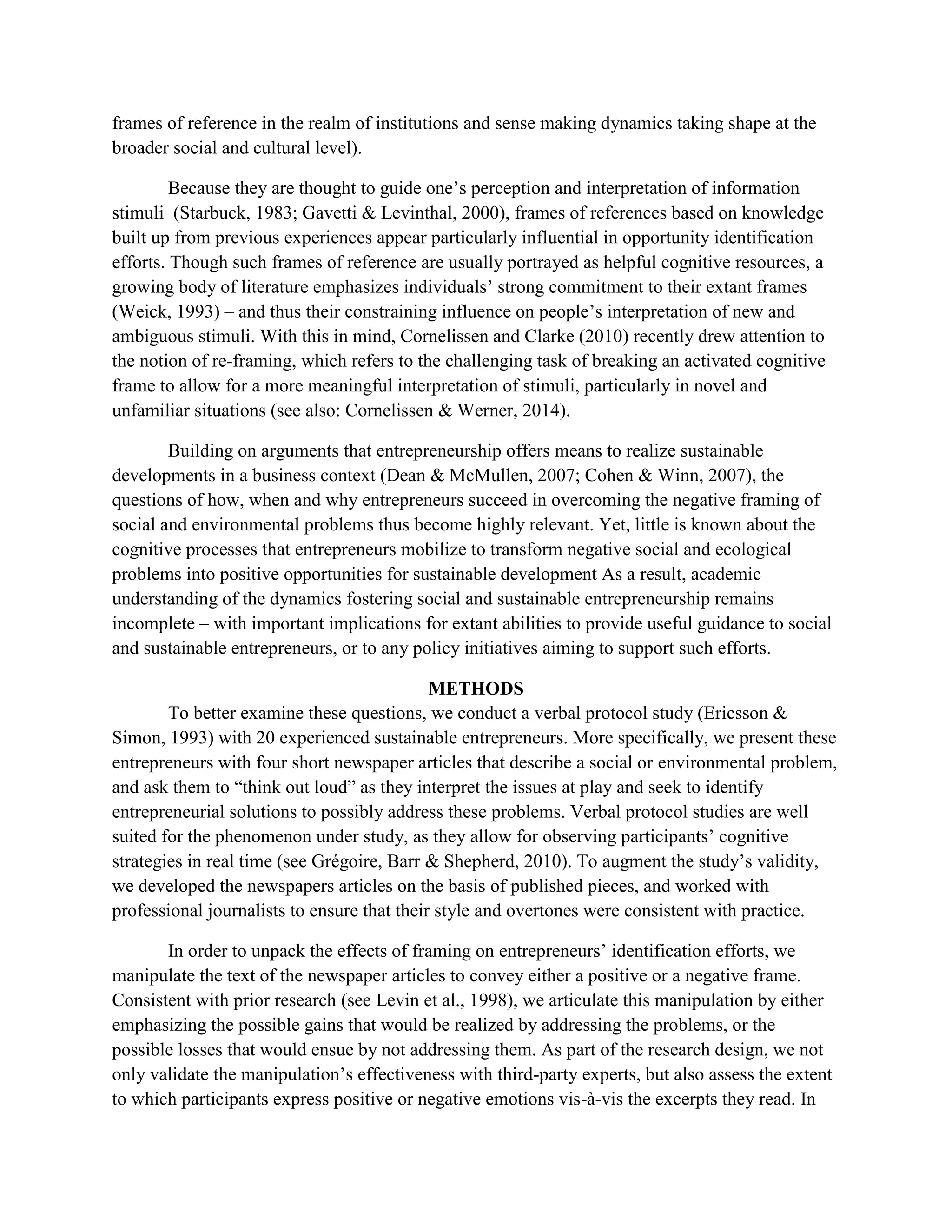
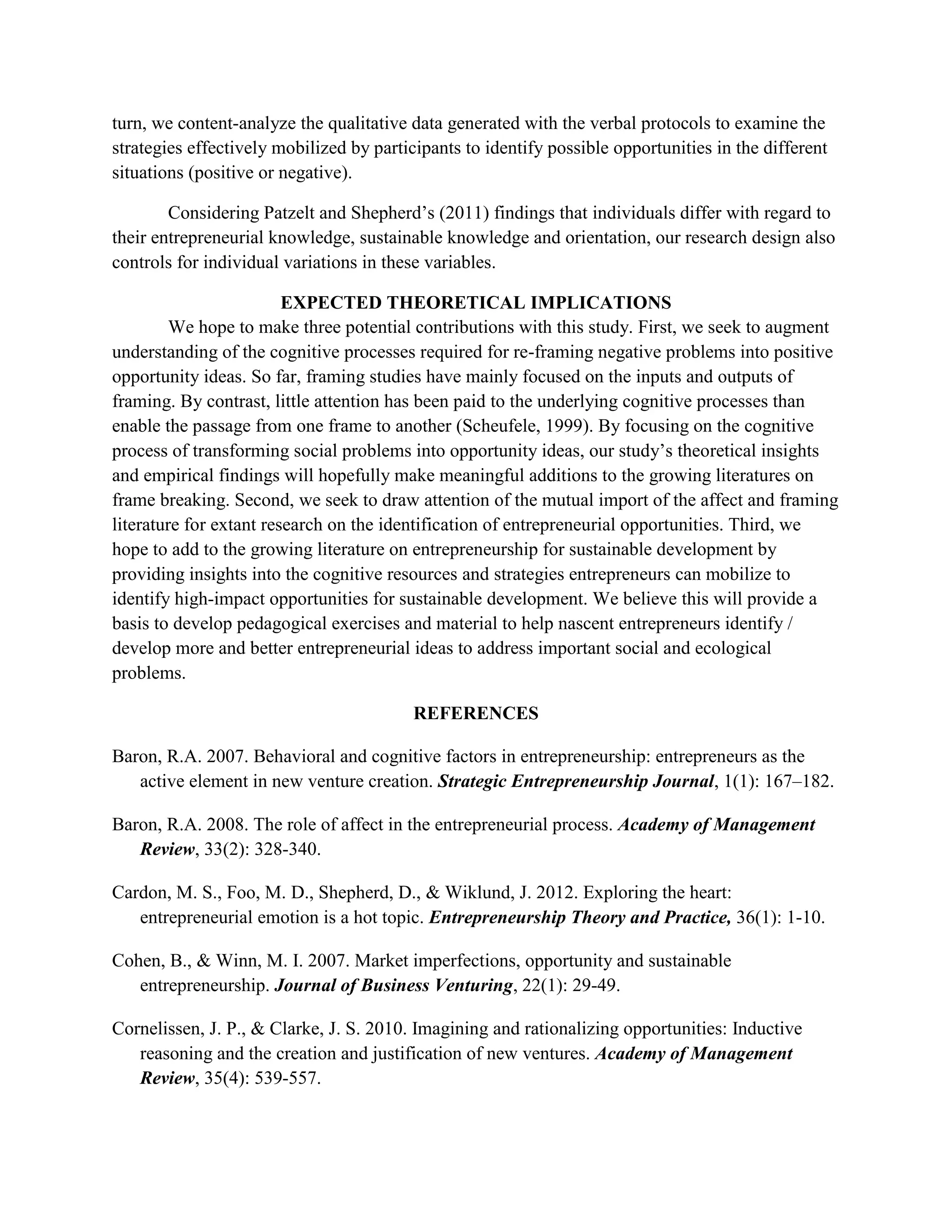

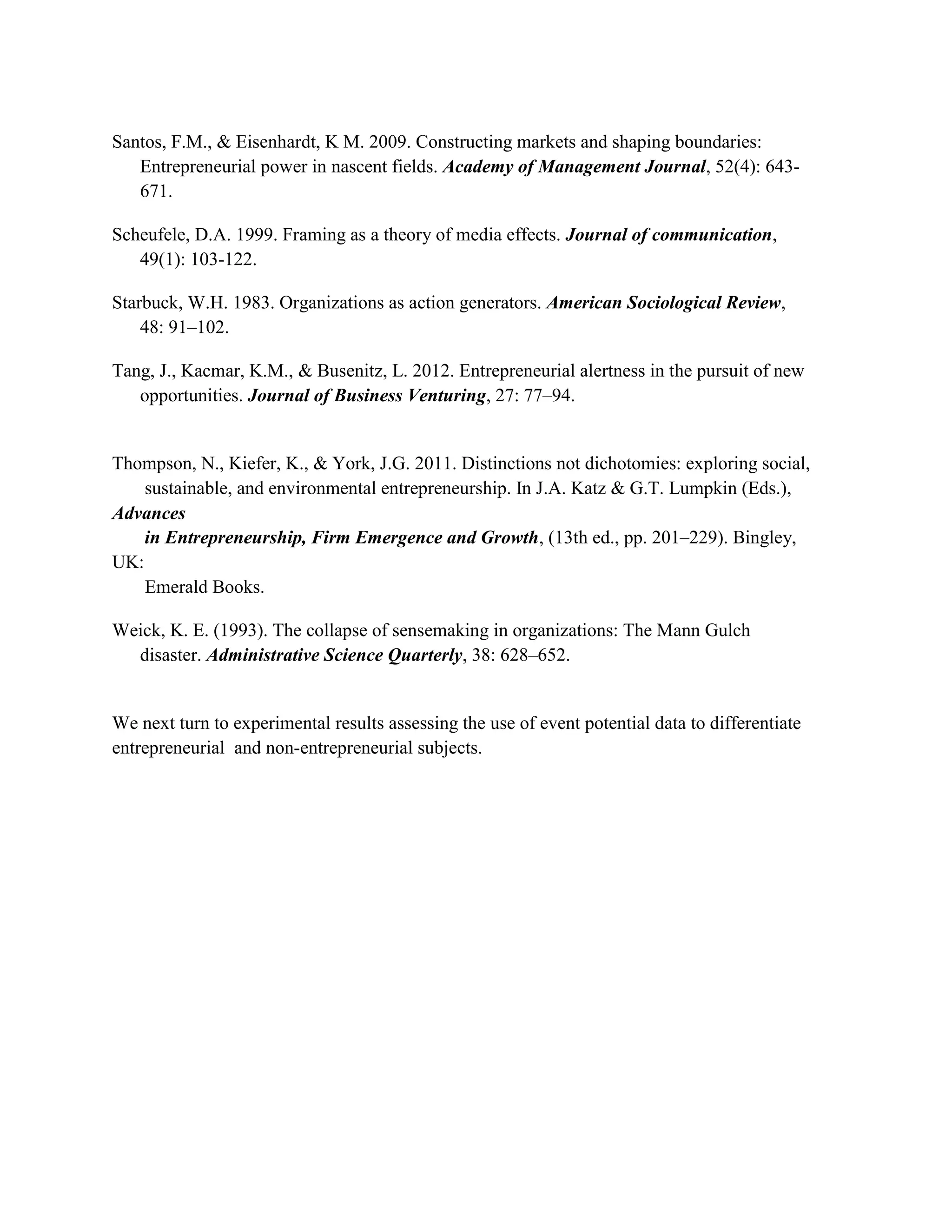

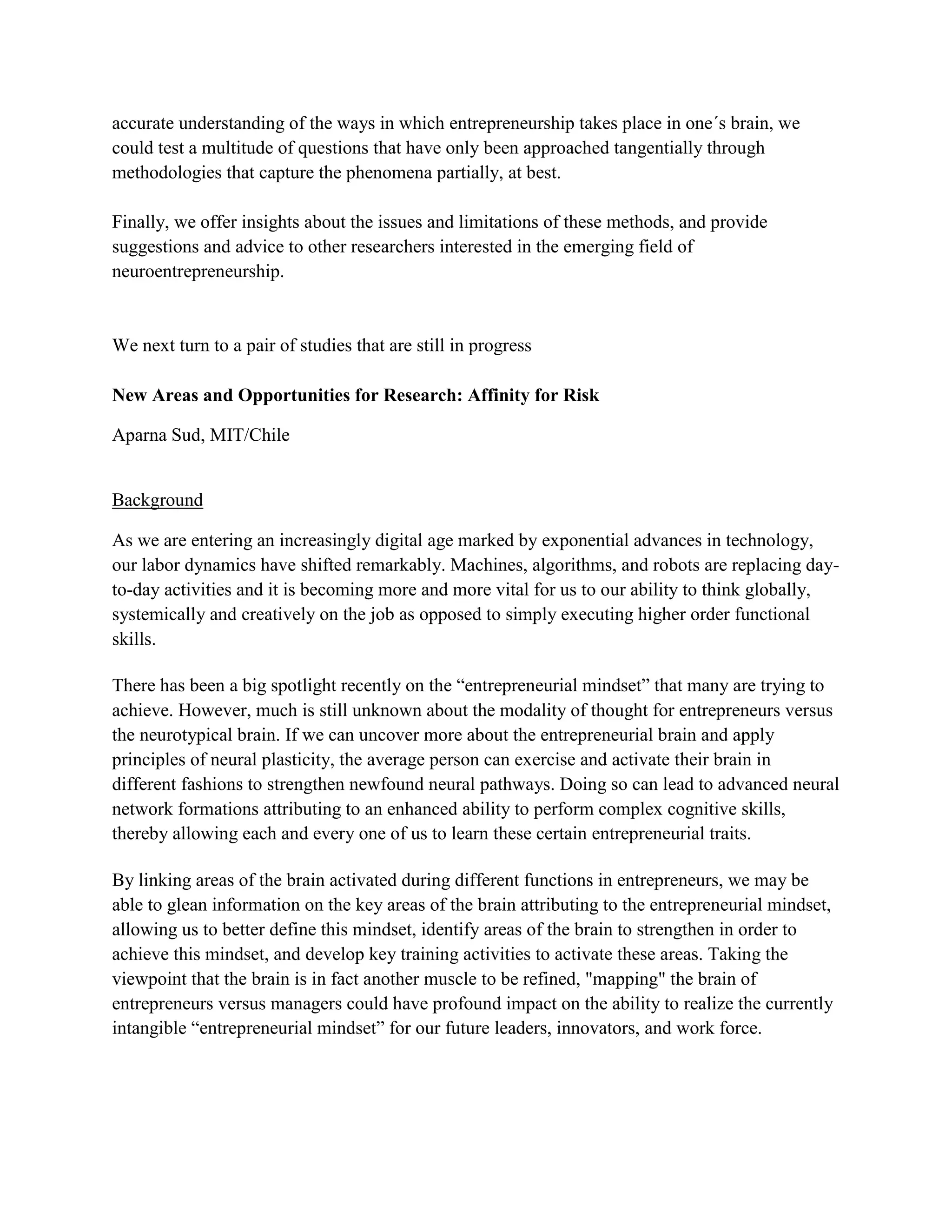
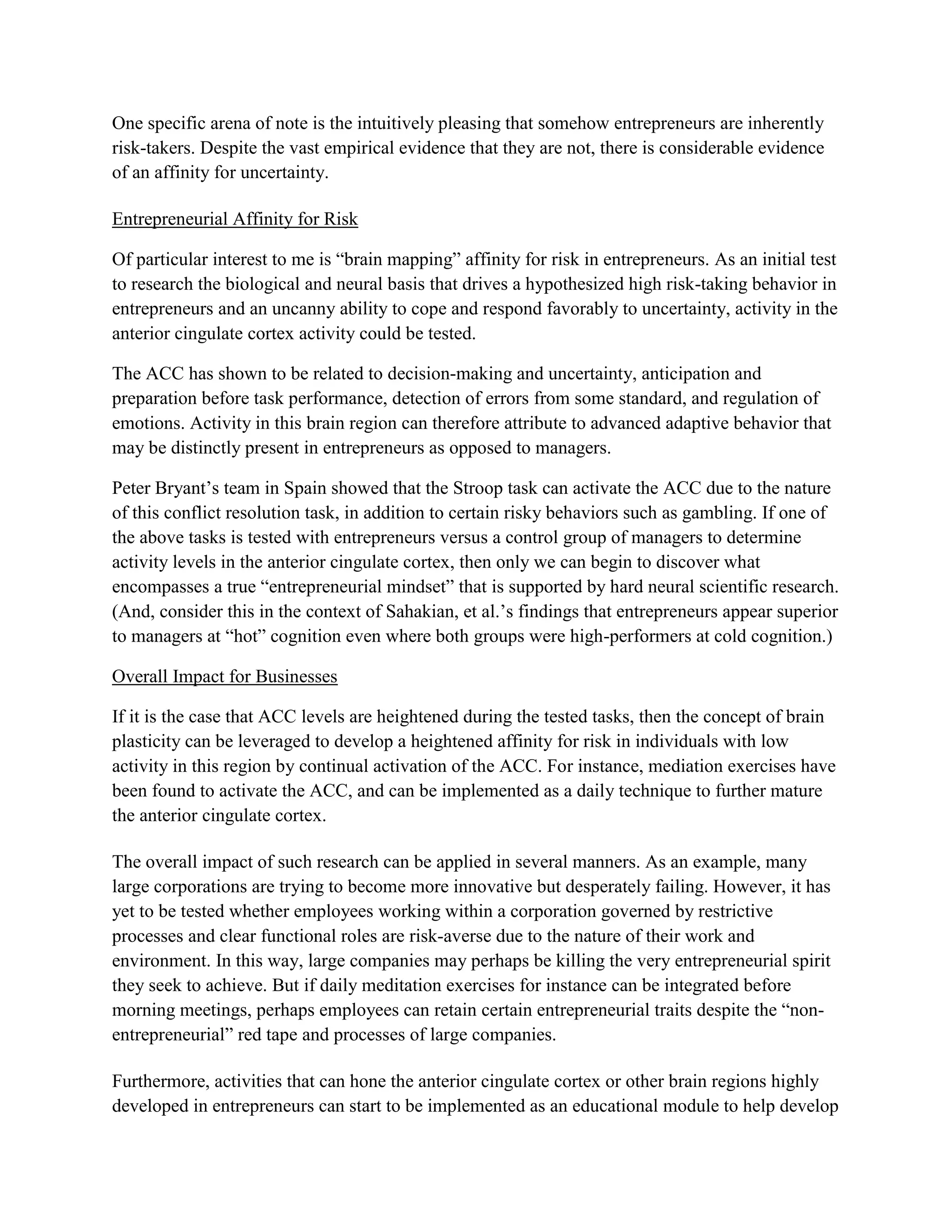
![our next generation of leaders, movers, shakers equipped with 21st
century skills. The hope being
that such an application can perhaps lead to an enhanced work force and improved economic
state over time.
Of course, the foregoing is speculative and hinges on great empirical work being done. As such,
I look forward to comments and ideas from the panel and audience.
Aparna Sud bio
Aparna Sud graduated from MIT with a dual degree in Management Science and Neuroscience.
She is fascinated in the new field of neuroentrepreneurship and the potential of up and coming
research in its ability to apply scientific discoveries of the brain to improve businesses and drive
overall economic growth.
Aparna has work experience in various sized organizations ranging from small startups to a
Fortune 500 financial service company. During her most recent engagement at Pfizer she helped
develop and implement innovative strategic projects for their BioTherapeutics R&D division.
She is actively involved in the local and global entrepreneurial scene through different
organizations such as H@cking Medicine, helping promote healthcare innovation through
worldwide hackathons, and Female Entrepreneurs of the World, supporting woman founders and
entrepreneurs in different cities worldwide through insights, events, and research.
Neuro…creativity?
Dina Pereira, University of Beira, Portugal
What defines a creative person? What characterizes an entrepreneur? What lies in the genesis of
these? Is an entrepreneur a creative person? Is it mapped somewhere inside the brain – the
propensity to be creative and to be entrepreneur?
Creativity can be defined as the ability to produce responses that are novel and appropriate to a
situation. Several studies point to diverse findings, suggesting that there exists an association
between creativity and 7R polymorphism in the dopamine receptor D4 gene (DRD4) (Mayseless
et al, 2013), others state that gray matter volume inside the brain affects individuals’ creativity
levels, that oxytonergic circuitry enables the day-to-day creativity humans (Li et al, 2014), that
some normal brains, performing better on standard creativity measures, are more “disinhibited”
in their organization, with certain regions having lower cortical volume (Jung et al., 2010c),
lower white matter fidelity (Jung et al, 2010a), and (at or below a verbal IQ of 116) anterior
cingulate biochemistry tending to “gate” frontal information flow (Jung et al, 2009a), that greater
functioning in frontoparietal and temporal regions, including the cingulate cortex (left anterior,
BA 32), hippocampus and amygdala, dorsolateral regions (Brodmann areas [BA] 8, 9, and 47),
lingual gyrus, temporal pole and orbitofrontal regions are related to creativity (Haller, 2014).](https://image.slidesharecdn.com/aom2015neurors15922-150507041018-lva1-app6891/75/Neuroentrepreneurship-symposium-2015-Academy-of-Management-17-2048.jpg)

